Software Security
Diomidis Spinellis
Department of Management Science and Technology
Athens University of Economics and Business
Athens, Greece
dds@aueb.gr
Principles for Software Security
- Secure the weakest link
Example:
social engineering attacks; attacks agains applications vs firewalls
- Defense in depth
Example:
use a VPN and encrypt your data
- Fail securely
Counterexample:
Pressing Esc on the Windows 95/98/Me login screen
(with domain login dissabled)
- Principle of least Privilege
Counterexample:
Unix programs running with superooser privileges.
Example: sendmail submission user.
- Compartmentalize
Counterexample:
Outlook HTML rendering engine.
- Keep it simple
Example:
choke point e.g. firewall.
Counterexample: security protocols, they are complex by neccessity, but
flaws are often found years after their introduction.
- Do not volunteer information
Example:
$ telnet relay2.ucia.gov smtp
Trying 198.81.129.194...
Connected to relay2.ucia.gov.
Escape character is '^]'.
220 ain-relay2.net.cia.gov SMTP Ready.
HELO aueb.gr
250 (aueb.gr) pleased to meet you.
Counterexample:
$ telnet mail.aueb.gr smtp
Trying 195.251.255.142...
Connected to hermes.aueb.gr.
Escape character is '^]'.
220 hermes.aueb.gr ESMTP Sendmail 8.12.9/8.12.9; Fri, 4 Jul 2003 12:53:14 +0300
HELO aueb.gr
250 hermes.aueb.gr Hello istlab.dmst.aueb.gr [195.251.253.207], pleased to meet you
- Hiding secrets is close to impossible
Example:
DVD DeCSS
- Be reluctant to trust
Counterexample:
downloading software
- Use community resources
Example:
public cryptographic algorithms and their implementations.
Buffer Overflows
- Cause of around 20-50% of all CERT security alerts
- Simple example (DOS attack)
$ cat bufftest.c
main()
{
char buff[20];
gets(buff);
puts(buff);
}
$ cc -o bufftest bufftest.c
/tmp/ccjCiHlw.o: In function `main':
/tmp/ccjCiHlw.o(.text+0xe): warning: this program uses gets(), which is unsafe.
$ ./bufftest
warning: this program uses gets(), which is unsafe.
normal text
normal text
$ ./bufftest
warning: this program uses gets(), which is unsafe.
text longer than the buffer size
text longer than the buffer size
Segmentation fault (core dumped)
How does a Buffer Overflow Work?
The attacker can execute code by corrupting the stack
This is the stack when gets is called:
+---------------+
| envp | Program's environment
+---------------+
| argv | Argument vector
+---------------+
| argc | Argument count
+---------------+
| _start | Return address of main
+---------------+
| buff[0] | First byte of buffer (e.g. 'n')
+---------------+
| buff[1] | Second byte of buffer (e.g. 'o')
+---------------+
| buff[...] | More buffer bytes
+---------------+
| buff[19] | Last byte of buffer
+---------------+
| main+12 | Return address of gets
+---------------+
This is the corrupted stack after an attack:
+---------------+
| envp | Program's environment
+---------------+
| argv | Argument vector
+---------------+
| argc | Argument count
+---------------+
| _start | Return address of main
+---------------+
| buff[0] |<-+ First byte of buffer (EVIL CODE)
+---------------+ |
| buff[1] | | Second byte of buffer (EVIL CODE)
+---------------+ |
| buff[...] | | More buffer bytes (more EVIL CODE)
+---------------+ |
| buff[19] | | Last byte of buffer
+---------------+ |
| &buff[0] |--^ Overwritten return address
+---------------+
Buffer Overflow Defences
- Use a language with strong typing and array checking
- Avoid fixed buffers
- Avoid unchecked routines using fixed buffers (e.g. gets, strcpy)
- Use routines that have buffer length as an argument (e.g. fgets, strncpy)
- Use libraries and execution environments that protect against stack
smashing attacks
- When writing to a fixed buffer, check index against the buffer's size
Unix Access Control
- Every user has a (typically unique) identifier
- Each user belongs to one or more groups
Example:
$ id
uid=1000(dds) gid=1000(dds) groups=1000(dds), 0(wheel), 10000(cvs), 20000(lh), 20001(dynweb), 20002(rpipe), 20003(postg), 20004(issues), 20005(dewdrop), 20006(eaware), 20007(mexpress), 20008(ivm), 20009(weblog), 20010(rng), 20011(uca)
- Each file belongs to a user and a group
- Each file or directory has a set of permissions associated with it
- Permissions are: write access, read access, execute permission
- A different permission set is specified for the file's user, group,
and all other users.
- On directories execute permission implies ability to traverse
- Executable files can be specified to run under the permission of their
owner or group (rather than the user executing them).
- A sepcial user, the super user (named root overrides all
access permissions
Example:
-r-xr-xr-x 1 root wheel 206740 Mar 27 15:42 /usr/bin/make
-r-sr-xr-x 1 man wheel 29752 Mar 27 15:39 /usr/bin/man
-r-sr-xr-x 2 root wheel 28828 Mar 27 15:42 /usr/bin/passwd
drwxr-xr-x 23 root wheel 1024 Jun 15 16:38 /usr/src
drwxrwxrwt 3 root wheel 512 Jul 4 13:24 /usr/tmp
drwxr-xr-x 2 root wheel 512 Dec 2 2002 /usr/var
drwxr-xr-x 13 root wheel 512 Jun 15 17:01 /usr/www
-rw------- 1 root wheel 5291 Jul 2 12:47 /etc/master.passwd
Windows Access Control
- Users belong to groups
- Preconfigured groups with useful default permissions
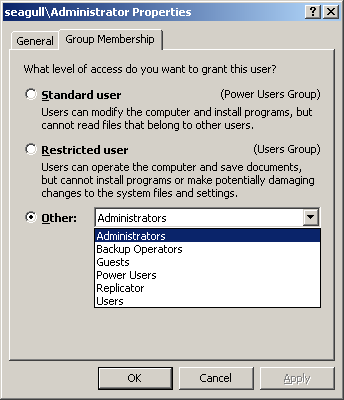
- Permissions to files are fine grained:
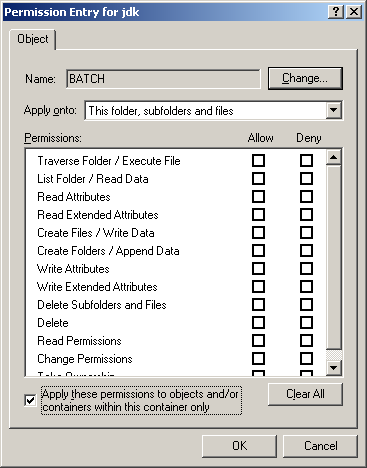
- File permissions can be specified for users, groups, or abstract entities
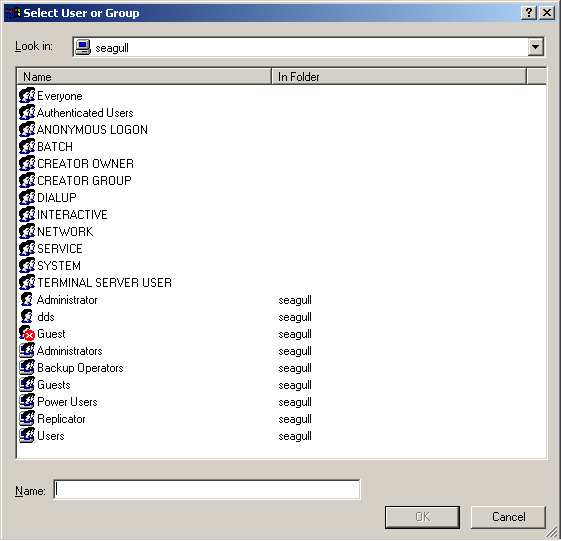
- Can also specify auditing on an element basis
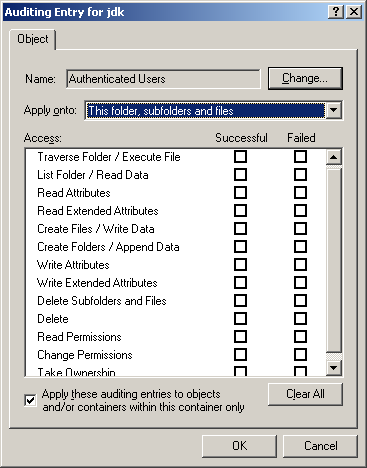
- Audit can generate log entries for success or failure
- A policy editor allows the centralized specification of the security policy
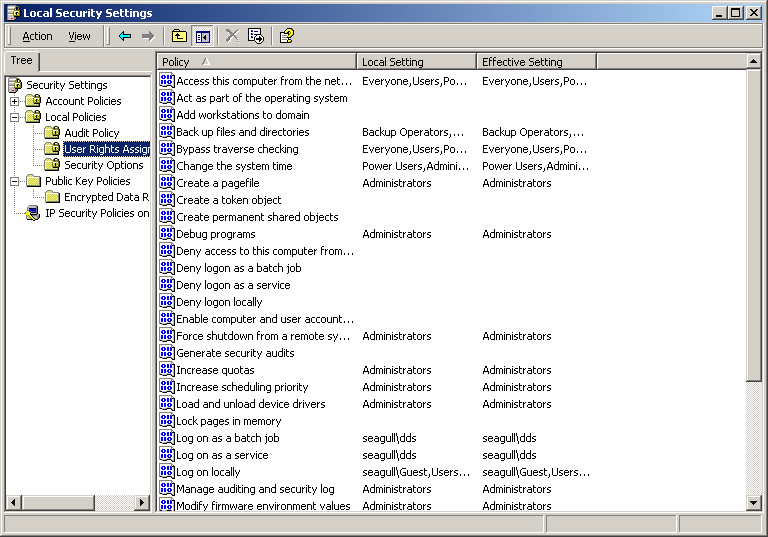
- Comprehensive, but complex system.
Few users and administrators understand it and use it correctly.
Race Conditions
- Expose a window of vulnerability
- Time of check different from time of use (TOCTOU)
and not an atomic operation
- Vulnerable:
- System objects (e.g. files) accessed across system calls (not atomic operations)
- Program objects (e.g. variables) in multithreaded programs
- Example:
if (can_access(file))
/* Window of vulnerability */
write_new_conents(file)
The attacker can:
$ touch my_file
$ privileged_program my_file &
$ rm my_file # Must be executed within the window
$ ln -s /etc/passwd my_file # Must be executed within the window
- Countermeasures:
- Use atomic operations (e.g. open/rename can create/rename a file or fail if the target file exists)
- Use locking in multithreaded programs (e.g. synchronized in Java code)
Problematic APIs
- Functions Susceptible to Buffer Overflows
- Format String Vulnerabilities
- Path and Shell Metacharacter Vulnerabilities
- Temporary Files
- Functions Unsuitable for Cryptographic Use
- Forgeable Data
Randomness and Determinism
Applying Cryptography
- Do not implement functions from scratch
- Use a crypto API (e.g. OpenSSL, Microsoft CryptoAPI)
- Careful on how you apply the primitives (e.g. avoid DES ECB mode)
- Careful on how you manage your keys
- Destroy data and keys when no more needed
Trust Management
- Trust is transitive
- Do not trust other programs you invoke (e.g. editor from a restricted shell)
- Do not trust input you do not control (e.g. hidden web fields)
- Do not trust code you do not control (e.g. Javascript validation)
- Be careful with metacharacters and interpreted languages
(Perl, SQL, sh, PHP, ASP)
Untrusted Input
- Environment variables
- Network data (e.g. DNS)
Result Verification
Failing to check the success of the Unix system calls
setuidsetegidsetgroups
or the Windows API calls
RpcImpersonateClientImpersonateLoggedOnUserCoImpersonateClientImpersonateNamedPipeClientImpersonateDdeClientWindowImpersonateSecurityContextImpersonateAnonymousTokenImpersonateSelfSetThreadToken
can result in a process running with elevated privileges.
Data and Privilege Leakage
Often consequence of discretionary access control.
- Data leakage
- Privilege leakage
- The Java approach
- Isolating privileged code
Password Authentication
- Check for good passwords when they are selected.
Dissallow:
- Short passwords
- Username appearing in password
- Only digits
- Only numbers
- Words in the dictionary (uppercase, lowercase, mixed)
- Do not store the encrypted password;
use the password to encrypt a known key.
- Protected the password databse to prevent dictionary attacks.
- Keep track of failed login attempts
- Even better, use variable passwords like SecureID
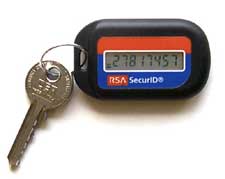
Database Security
- Communication is typically unencrypted, therefore restrict it
beyond the firewall.
- Enforce database level security
- Create database users
- Grant access for specific objects and actions (SELECT, INSERT, DELETE, UPDATE)
- Use separate users and permissions for web and maintenance access.
- Careful where you store the database access passwords (client applications)
- Keep in mind statistical attacks
Application Security
Copy protection measures:
- Floating network licenses
- Hardware dongles
- Node locking
Tamperproofing:
- Add antidebugging measures
- Checksum the code
- Plant decoys
- Avoid direct responses
- Code obfuscation
- Code and data encryption
Keep in mind that the attacker has complete control of your application.
Bibliography
- Matt Bishop and
Michael Dilger.
Checking for race conditions in file accesses.
Computing Systems, 9(2):131–152, Spring 1996.
- Michael Howard and
David LeBlanc.
Writing Secure Code.
Microsoft Press, Redmond, WA, second edition, 2003.
- Gary McGraw and
Edward W. Felten.
Securing Java: Getting Down to Business with Mobile Code.
Wiley, New York, 1999.
- Diomidis Spinellis.
Reflection as a mechanism for software integrity verification ( http://www.spinellis.gr/pubs/jrnl/1999-TISS-Reflect/html/reflect.html).
ACM Transactions on Information and System Security, 3(1):51–62,
February 2000.
- John Viega and Gary
McGraw.
Building Secure Software: How to Avoid Security Problems the Right Way.
Addison-Wesley, 2001.
- J. Viega, J. T. Bloch,
Y. Kohno, and G. McGraw.
Its4: A static vulnerability scanner for c and c++ code.
In Proceedings of the 16th Annual Computer Security Applications
Conference (ACSAC'00), page 257. IEEE Computer Society, 2000.










